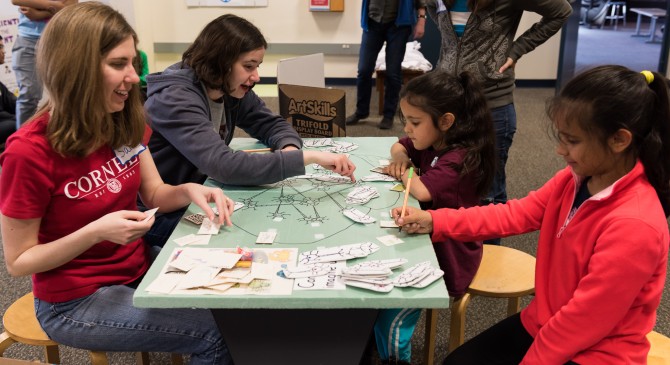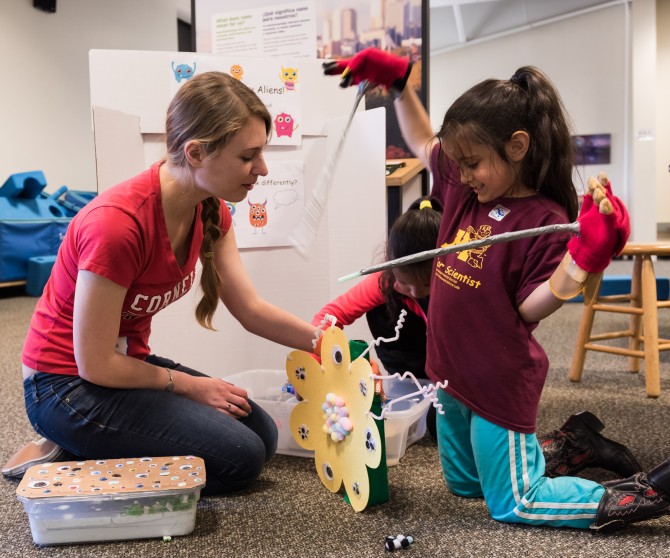Fun, hands-on course teaches science communication
By Linda B. Glaser
When the 11 students in Psych 4500 – Psychology at the Sciencenter – first walked into their classroom in Uris Hall, instead of chairs they found a “maker” space: walls lined with shelves of crafts supplies like glue, string, foam board, nails, marbles and the ever-versatile duct tape.
Their first assignment: Create a science exhibit based on a simple description.
In groups, the students constructed a hot air balloon, a roller coaster, a windmill and more. And while creating the exhibit was a challenge, recalled doctoral student Samantha Carouso Peck, “it paled in comparison to the next task: to write a clear description for a demo ourselves, when we were provided only with a scientific concept we needed to convey.” Her group’s topic was transfer of energy through a fluid medium. Their solution was an activity that asked participants to construct a vessel and find two different techniques to propel it across a tub of water without using their hands.
“This is by far the most rewarding and challenging course I’ve ever taught,” said Michael Goldstein, associate professor of psychology. His usual research focuses on the evolution and development of vocal learning in birds and babies, and learning about science communication was a whole new field for him and Khena Swallow, assistant professor of psychology, whose research focuses on attention and memory in adults.
The idea for the class arose when Swallow noticed the lack of psychology or neuroscience exhibits at the Sciencenter. It turns out that nationally – and internationally – cognitive science exhibits are rare, especially interactive ones.
The course goal is to produce one or two polished exhibit ideas the Sciencenter can use. Since Goldstein and Swallow plan to offer the spring semester class on an ongoing basis – it will be a 2017-18 University Course – after four or five years they hope to have a suite of exhibits developed about psychological science.
“We wanted our audience to learn about psychology, what scientists know about how people learn and develop, and our audience definitely got that,” said Michelle Kortenaar, senior director of engagement and learning at the Sciencenter. Some of the students’ prototypes could be converted into stand-alone exhibits or used as facilitated exhibits, she added.
Sciencenter staff provided guidance in how to develop an exhibit that considers the interests of the audience and how to evaluate an exhibit’s effectiveness, working with the students during and outside of class. Bruce Lewenstein, specialist in science communication and chair of the Department of Science and Technology Studies, served in an advisory role.
For Sarah Dincin ’19, the town-gown connection was critical. “The most important thing I discovered this semester is how much we as students/Cornellians can learn from members of the Ithaca community,” she said. “It has been incredible to be able to communicate directly with children and their parents at the Sciencenter, and their feedback was instrumental in our prototype design process.”
The course was supported by an Engaged Cornell grant that enabled Goldstein and Swallow to visit numerous science and children’s museums to learn best practices; the grant also supported the Sciencenter’s contributions to the course.
The students’ course challenge was to create interactive exhibits that allow children to experiment, analyze and think independently.
One of the designs, “Hungry Hungry Aliens,” demonstrated embodied cognition – that changing your body changes how you think about the world. Participants wore gloves that turned their hands into different types of alien hands, which they could use to catch food in different environments. By switching gloves, children learned that cognition changes when your body or environment changes.
“I was surprised at how hard it actually is to create a functional science exhibit that successfully engages audiences,” said class participant Caitlyn Finton, a doctoral student.
Swallow said that the students’ remarkable ideas and creativity exceeded her and Goldstein’s expectations when they began the course. The students’ successful efforts have already generated interest beyond the Sciencenter: Goldstein and Swallow have been contacted by area preschools as well as the New York State Fair.
Linda B. Glaser is a writer for the College of Arts and Sciences.
Media Contact
Get Cornell news delivered right to your inbox.
Subscribe
